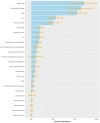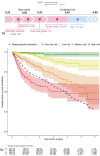UroPredict: Machine learning model on real-world data for prediction of kidney cancer recurrence (UroCCR-120)
- PMID: 38396089
- PMCID: PMC10891119
- DOI: 10.1038/s41698-024-00532-x
UroPredict: Machine learning model on real-world data for prediction of kidney cancer recurrence (UroCCR-120)
Abstract
Renal cell carcinoma (RCC) is most often diagnosed at a localized stage, where surgery is the standard of care. Existing prognostic scores provide moderate predictive performance, leading to challenges in establishing follow-up recommendations after surgery and in selecting patients who could benefit from adjuvant therapy. In this study, we developed a model for individual postoperative disease-free survival (DFS) prediction using machine learning (ML) on real-world prospective data. Using the French kidney cancer research network database, UroCCR, we analyzed a cohort of surgically treated RCC patients. Participating sites were randomly assigned to either the training or testing cohort, and several ML models were trained on the training dataset. The predictive performance of the best ML model was then evaluated on the test dataset and compared with the usual risk scores. In total, 3372 patients were included, with a median follow-up of 30 months. The best results in predicting DFS were achieved using Cox PH models that included 24 variables, resulting in an iAUC of 0.81 [IC95% 0.77-0.85]. The ML model surpassed the predictive performance of the most commonly used risk scores while handling incomplete data in predictors. Lastly, patients were stratified into four prognostic groups with good discrimination (iAUC = 0.79 [IC95% 0.74-0.83]). Our study suggests that applying ML to real-world prospective data from patients undergoing surgery for localized or locally advanced RCC can provide accurate individual DFS prediction, outperforming traditional prognostic scores.
© 2024. The Author(s).
Conflict of interest statement
The authors declare no competing interests.
Figures






Similar articles
-
Machine-learning approach for prediction of pT3a upstaging and outcomes of localized renal cell carcinoma (UroCCR-15).BJU Int. 2023 Aug;132(2):160-169. doi: 10.1111/bju.15959. Epub 2023 Feb 1. BJU Int. 2023. PMID: 36648124
-
Application of Machine Learning Models to Predict Recurrence After Surgical Resection of Nonmetastatic Renal Cell Carcinoma.Eur Urol Oncol. 2023 Jun;6(3):323-330. doi: 10.1016/j.euo.2022.07.007. Epub 2022 Aug 18. Eur Urol Oncol. 2023. PMID: 35987730
-
Predicting Disease Recurrence, Early Progression, and Overall Survival Following Surgical Resection for High-risk Localized and Locally Advanced Renal Cell Carcinoma.Eur Urol. 2021 Jul;80(1):20-31. doi: 10.1016/j.eururo.2021.02.025. Epub 2021 Mar 9. Eur Urol. 2021. PMID: 33707112 Free PMC article.
-
Overview of resistance to systemic therapy in patients with breast cancer.Adv Exp Med Biol. 2007;608:1-22. doi: 10.1007/978-0-387-74039-3_1. Adv Exp Med Biol. 2007. PMID: 17993229 Review.
-
Adjuvant therapy with tyrosine kinase inhibitors for localized and locally advanced renal cell carcinoma: an updated systematic review and meta-analysis.Urol Oncol. 2021 Nov;39(11):764-773. doi: 10.1016/j.urolonc.2021.07.022. Epub 2021 Aug 14. Urol Oncol. 2021. PMID: 34400065
Cited by
-
Transcriptome-based network analysis related to regulatory T cells infiltration identified RCN1 as a potential biomarker for prognosis in clear cell renal cell carcinoma.BioData Min. 2024 Nov 14;17(1):51. doi: 10.1186/s13040-024-00404-x. BioData Min. 2024. PMID: 39543725 Free PMC article.
-
Construction of a prognostic prediction model for colorectal cancer based on 5-year clinical follow-up data.Sci Rep. 2025 Jan 21;15(1):2701. doi: 10.1038/s41598-025-86872-5. Sci Rep. 2025. PMID: 39838027 Free PMC article.
-
Regression analysis and validation of risk factors for upper limb dysfunction following modified radical mastectomy for breast cancer patients.Am J Transl Res. 2025 Apr 15;17(4):2614-2628. doi: 10.62347/CZYA6232. eCollection 2025. Am J Transl Res. 2025. PMID: 40385071 Free PMC article.
-
Immune-Based and Novel Therapies in Variant Histology Renal Cell Carcinomas.Cancers (Basel). 2025 Jan 20;17(2):326. doi: 10.3390/cancers17020326. Cancers (Basel). 2025. PMID: 39858107 Free PMC article. Review.
-
External Validation of the GRade, Age, Nodes and Tumor (GRANT) Score for Patients with Surgically Treated Papillary Renal Cell Carcinoma.Technol Cancer Res Treat. 2025 Jan-Dec;24:15330338251329848. doi: 10.1177/15330338251329848. Epub 2025 Mar 25. Technol Cancer Res Treat. 2025. PMID: 40129395 Free PMC article.
References
LinkOut - more resources
Full Text Sources

